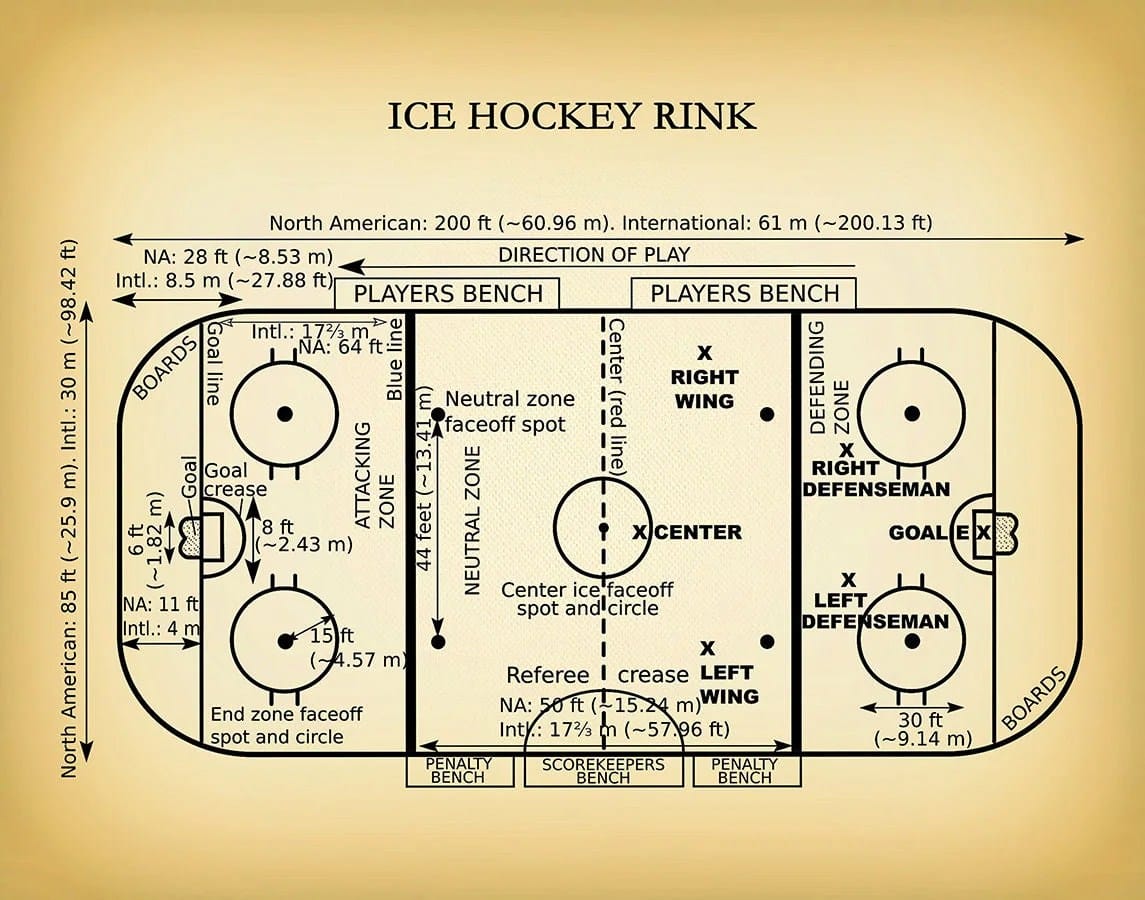Ever wonder why NHL hockey feels so fast and furious? A big part of it is the rink itself. It’s a carefully designed battleground where dimensions dictate the game’s pulse. This guide breaks down the exact measurements of an NHL rink—200 feet by 85 feet—and reveals how this size translates into non-stop action. We’ll also explore how NHL rinks compare to their larger international counterparts and why that difference changes everything from passing plays to goal-scoring opportunities. So, if you’re curious about the unique nature of NHL hockey, get ready to uncover the secrets hidden within the rink’s lines.
The Ice: A Frozen Battlefield
The National Hockey League rink, where legends are forged, isn’t just a sheet of ice—it’s a precisely measured stage, 200 feet long by 85 feet wide. These dimensions are fundamental to the sport’s thrilling nature. This standardized size, smaller than international rinks, creates a unique brand of high-octane action. Less space likely means more player contact, more battles for the puck, and a heightened sense of intensity.
Zones of Engagement: Dissecting the Ice
The ice surface is strategically divided into distinct zones. Two blue lines, 75 feet from each end, separate offensive and defensive territories. The 50-foot neutral zone between them is a constant battleground for possession. These lines dictate much of the game, impacting offsides calls and strategic positioning. A player’s location relative to these lines can distinguish a brilliant offensive maneuver from a costly turnover. Ever wondered how the Arizona diamondbacks on scoreboards are represented in different stadiums?
The 28-Foot Curve: A Game Changer
The rink’s corners aren’t sharp angles but curves with a 28-foot radius. This seemingly minor detail significantly impacts game flow. These curved corners become hotbeds of activity where quick thinking and slick stickhandling are essential. It’s akin to a tight turn on a racetrack, demanding both speed and skill.
Behind the Net: The Crucial 11 Feet
The 11-foot zone between the goal line and the boards at each end is a critical battleground. It’s where goalies position themselves, players scramble for loose pucks, and nail-biting, last-second plays often unfold. This small area can witness some of the most intense moments in a hockey game. And for a deeper dive into legal history, explore the complexities of chimel v california and its impact.
NHL vs. International: A Tale of Two Sizes
International rinks, typically 197 feet by 98.4 feet, offer a more expansive playing surface. This added width changes the game’s dynamics, allowing for a more flowing, European-style approach emphasizing skating and passing. The NHL’s tighter dimensions contribute to its signature fast-paced, physical play.
Size Matters: Speed, Physicality, and Strategy
An NHL rink’s dimensions aren’t arbitrary. They are the blueprint of the sport, deeply influencing its speed, physicality, and strategic complexity. The smaller ice amplifies the speed and intensity, making every inch contested. It’s a high-stakes chess match on skates, played out on a precisely defined battlefield.
| Feature | NHL Rink (feet) | International Rink (feet) |
|---|---|---|
| Length | 200 | 197 |
| Width | 85 | 98.4 |
| Corner Radius | 28 | 28 |
These dimensions shape the game’s rhythm, flow, and unique character. Ongoing research into game dynamics might further illuminate the intricate relationship between rink size and gameplay.
NHL Rink Size: A Deep Dive
A standard NHL rink is precisely 200 feet long by 85 feet wide (approximately 60.96 meters by 25.9 meters). This standardized size ensures fair competition across all NHL teams. This consistency eliminates any potential “home-ice advantage” based on varying rink dimensions, keeping the focus on player skills and team strategy.
International rinks are typically larger, around 197 feet long by 98.5 feet wide. This added width significantly opens up the game, allowing for more fluid skating and complex passing plays. It’s less of a physical battle and more of a strategic ballet on ice.
Why does this size difference matter? The narrower NHL rink creates a faster, more physical game. Players battle fiercely for every inch of space, leading to quicker transitions and less reaction time. There’s simply less margin for error. Subtle features like the 28-foot corner radius and the strategically placed blue lines further enhance the game’s complexity, influencing puck retrieval, offensive plays, and critical rules like icing and offsides.
While the current standard dimensions are well-established, the interplay of rules, rink dimensions, and player skill keeps the sport dynamic. Future adjustments are possible, driven by evolving playing styles or new research on player safety.
Olympic vs. NHL: A Size Showdown
The difference between NHL and Olympic rink sizes goes beyond just extra space; it fundamentally alters the game’s feel. An Olympic-sized rink maintains the 200-foot length but expands to 100 feet wide, adding 3,000 square feet of playing surface.
| Feature | NHL Rink | Olympic Rink | Difference |
|---|---|---|---|
| Length | 200 feet | 200 feet | 0 feet |
| Width | 85 feet | 100 feet | 15 feet |
| Total Area | 17,000 sq ft | 20,000 sq ft | 3,000 sq ft |
This increased space allows for longer, cross-ice passes, stretching defenses thin and creating more scoring opportunities. The larger ice also influences the game’s tempo and strategy. NHL’s tighter confines promote a more physical style, while the Olympic rink allows for more fluid, creative play. This impacts defensive strategies too, demanding greater mobility and awareness from defenders. It also explains why NHL players often require time to adapt to the larger international ice. While current research suggests this size difference significantly impacts gameplay, the complexities of hockey leave room for further study.
Why Bigger Rinks in Europe?
The difference in rink size between the NHL and European leagues significantly impacts the playing style. NHL rinks (200 ft x 85 ft) prioritize speed and physicality due to the limited space. European rinks, adhering to IIHF standards (typically 197 ft x 98.5 ft, with a minimum width of 85.3ft although rarely at the minimum) promote skill and strategy. The extra width allows for more strategic play, intricate puck handling, and creative passing.
This isn’t merely a European preference; it’s driven by IIHF regulations. Growing up on larger ice cultivates superior puck-handling and passing skills among European players. Coaches also adapt their strategies based on rink size, with NHL coaches focusing on quick transitions and aggressive forechecking, while European coaches utilize more complex offensive schemes.
| Rink Feature | NHL Rink | IIHF/European Rink |
|---|---|---|
| Length | 200 ft | 197 ft |
| Width | 85 ft | 98.5 ft (min. 85.3 ft) |
| Gameplay Emphasis | Speed, Physicality | Skill, Strategy |
| Player Development | Quick plays, physical battles | Puck control, passing |
| Coaching Strategies | Quick transitions, forechecking | Creative passing, east-west movement |
While these are general tendencies, rink size is a major factor shaping the overall style of play in different leagues, contributing to the diverse nature of hockey worldwide.
- China II Review: Delicious Food & Speedy Service - April 17, 2025
- Understand Virginia’s Flag: History & Debate - April 17, 2025
- Explore Long Island’s Map: Unique Regions & Insights - April 17, 2025
















